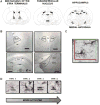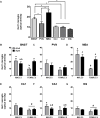Stereological Analysis of Microglia in Aged Male and Female Fischer 344 Rats in Socially Relevant Brain Regions
- PMID: 29496632
- PMCID: PMC5882587
- DOI: 10.1016/j.neuroscience.2018.02.028
Stereological Analysis of Microglia in Aged Male and Female Fischer 344 Rats in Socially Relevant Brain Regions
Abstract
Aging is associated with a substantial decline in the expression of social behavior as well as increased neuroinflammation. Since immune activation and subsequent increased expression of cytokines can suppress social behavior in young rodents, we examined age and sex differences in microglia within brain regions critical to social behavior regulation (PVN, BNST, and MEA) as well as in the hippocampus. Adult (3-month) and aged (18-month) male and female F344 (N = 26, n = 5-8/group) rats were perfused and Iba-1 immunopositive microglia were assessed using unbiased stereology and optical density. For stereology, microglia were classified based on the following criteria: (1) thin ramified processes, (2) thick long processes, (3) stout processes, or (4) round/ameboid shape. Among the structures examined, the highest density of microglia was evident in the BNST and MEA. Aged rats of both sexes displayed increased total number of microglia number exclusively in the MEA. Sex differences also emerged, whereby aged females (but not males) displayed greater total number of microglia in the BNST relative to their young adult counterparts. When morphological features of microglia were assessed, aged rats exhibited increased soma size in the BNST, MEA, and CA3. Together, these findings provide a comprehensive characterization of microglia number and morphology under ambient conditions in CNS sites critical for the normal expression of social processes. To the extent that microglia morphology is predictive of reactivity and subsequent cytokine release, these data suggest that the expression of social behavior in late aging may be adversely influenced by heightened inflammation.
Keywords: Fischer 344; aging; limbic system; microglia; rat; social behavior.
Copyright © 2018 IBRO. Published by Elsevier Ltd. All rights reserved.
Conflict of interest statement
The authors have no conflicts of interest to declare.
Figures




Similar articles
-
Impact of housing conditions on social behavior, neuroimmune markers, and oxytocin receptor expression in aged male and female Fischer 344 rats.Exp Gerontol. 2019 Aug;123:24-33. doi: 10.1016/j.exger.2019.05.005. Epub 2019 May 14. Exp Gerontol. 2019. PMID: 31100373 Free PMC article.
-
A working model for the assessment of disruptions in social behavior among aged rats: The role of sex differences, social recognition, and sensorimotor processes.Exp Gerontol. 2016 Apr;76:46-57. doi: 10.1016/j.exger.2016.01.012. Epub 2016 Jan 23. Exp Gerontol. 2016. PMID: 26811912 Free PMC article.
-
Sequential activation of microglia and astrocyte cytokine expression precedes increased Iba-1 or GFAP immunoreactivity following systemic immune challenge.Glia. 2016 Feb;64(2):300-16. doi: 10.1002/glia.22930. Epub 2015 Oct 15. Glia. 2016. PMID: 26470014 Free PMC article.
-
Microglia phenotype diversity.CNS Neurol Disord Drug Targets. 2011 Feb;10(1):108-18. doi: 10.2174/187152711794488575. CNS Neurol Disord Drug Targets. 2011. PMID: 21143141 Review.
-
Nutrients, Microglia Aging, and Brain Aging.Oxid Med Cell Longev. 2016;2016:7498528. doi: 10.1155/2016/7498528. Epub 2016 Jan 31. Oxid Med Cell Longev. 2016. PMID: 26941889 Free PMC article. Review.
Cited by
-
From adolescence to late aging: A comprehensive review of social behavior, alcohol, and neuroinflammation across the lifespan.Int Rev Neurobiol. 2019;148:231-303. doi: 10.1016/bs.irn.2019.08.001. Epub 2019 Aug 24. Int Rev Neurobiol. 2019. PMID: 31733665 Free PMC article. Review.
-
Different Methods for Evaluating Microglial Activation Using Anti-Ionized Calcium-Binding Adaptor Protein-1 Immunohistochemistry in the Cuprizone Model.Cells. 2022 May 24;11(11):1723. doi: 10.3390/cells11111723. Cells. 2022. PMID: 35681418 Free PMC article.
-
Alterations of Both Dendrite Morphology and Weaker Electrical Responsiveness in the Cortex of Hip Area Occur Before Rearrangement of the Motor Map in Neonatal White Matter Injury Model.Front Neurol. 2018 Jun 19;9:443. doi: 10.3389/fneur.2018.00443. eCollection 2018. Front Neurol. 2018. PMID: 29971036 Free PMC article.
-
Microglia in Alzheimer Disease: Well-Known Targets and New Opportunities.Front Aging Neurosci. 2019 Aug 30;11:233. doi: 10.3389/fnagi.2019.00233. eCollection 2019. Front Aging Neurosci. 2019. PMID: 31543810 Free PMC article. Review.
-
Sex differences in dopamine innervation and microglia are altered by synthetic progestin in neonatal medial prefrontal cortex.J Neuroendocrinol. 2021 Mar;33(3):e12962. doi: 10.1111/jne.12962. J Neuroendocrinol. 2021. PMID: 33719165 Free PMC article.
References
-
- Abràmoff MD, Magalhães PJ, Ram SJ. Image processing with imageJ. Biophotonics Int. 2004;11:36–41. doi: 10.1117/1.3589100. - DOI
-
- Adams MM, Shi L, Linville MC, Forbes ME, Long AB, Bennett C, Newton IG, Carter CS, Sonntag WE, Riddle DR, Brunso-Bechtold JK. Caloric restriction and age affect synaptic proteins in hippocampal CA3 and spatial learning ability. Exp. Neurol. 2008;211:141–149. doi: 10.1016/j.expneurol.2008.01.016. - DOI - PMC - PubMed
Publication types
MeSH terms
Grants and funding
LinkOut - more resources
Full Text Sources
Other Literature Sources
Medical
Miscellaneous

